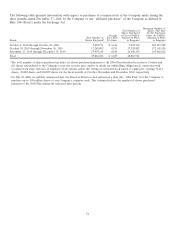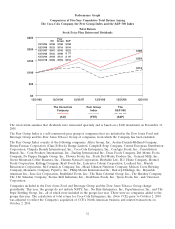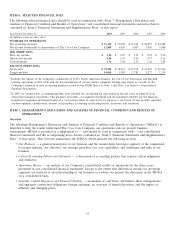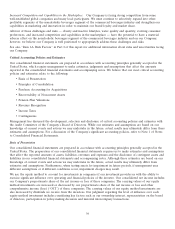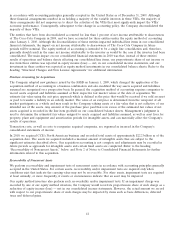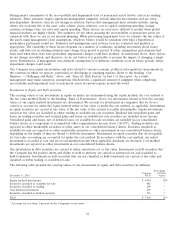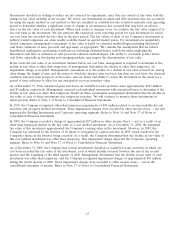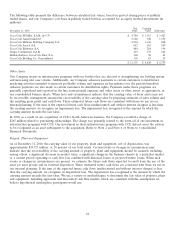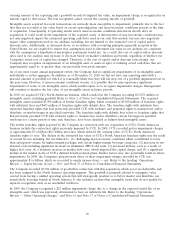Coca Cola 2010 Annual Report Download - page 42
Download and view the complete annual report
Please find page 42 of the 2010 Coca Cola annual report below. You can navigate through the pages in the report by either clicking on the pages listed below, or by using the keyword search tool below to find specific information within the annual report.We eliminate from our financial results all significant intercompany transactions, including the intercompany
transactions with consolidated VIEs and the intercompany portion of transactions with equity method investees.
Accounting principles generally accepted in the United States provide entities the option to measure many financial
instruments and certain other items at fair value, with the change in fair value being included in the determination of
net income. The Company has currently chosen not to elect the fair value option; and therefore, we only measure assets
and liabilities at fair value if required under other accounting guidance.
Certain amounts in the prior years’ consolidated financial statements and notes have been revised to conform to the
current year presentation.
Principles of Consolidation
Our Company consolidates all entities that we control by ownership of a majority voting interest as well as VIEs for
which our Company is the primary beneficiary. Generally, we consolidate only business enterprises that we control by
ownership of a majority voting interest. However, there are situations in which consolidation is required even though
the usual condition of consolidation (ownership of a majority voting interest) does not apply. Generally, this occurs
when an entity holds an interest in another business enterprise that was achieved through arrangements that do not
involve voting interests, which results in a disproportionate relationship between such entity’s voting interests in, and its
exposure to the economic risks and potential rewards of, the other business enterprise. This disproportionate
relationship results in what is known as a variable interest, and the entity in which we have the variable interest is
referred to as a VIE. An enterprise must consolidate a VIE if it is determined to be the primary beneficiary of the
VIE. The primary beneficiary has both (a) the power to direct the activities of the VIE that most significantly impact
the entity’s economic performance, and (b) the obligation to absorb losses or the right to receive benefits from the VIE
that could potentially be significant to the VIE.
Our Company holds interests in certain VIEs, primarily bottling and container manufacturing operations, for which we
were not determined to be the primary beneficiary. Our variable interests in these VIEs primarily relate to profit
guarantees or subordinated financial support. Refer to Note 11. Although these financial arrangements resulted in us
holding variable interests in these entities, the majority of these arrangements did not empower us to direct the
activities of the VIEs that most significantly impact the VIEs’ economic performance. Our Company’s investments, plus
any loans and guarantees, related to these VIEs totaled approximately $1,274 million and $624 million as of
December 31, 2010, and 2009, respectively, representing our maximum exposures to loss. The Company’s investments,
plus any loans and guarantees, related to these VIEs were not significant to the Company’s consolidated financial
statements.
In addition, our Company holds interests in certain VIEs, primarily bottling and container manufacturing operations,
for which we were determined to be the primary beneficiary. Our Company’s investments, plus any loans and
guarantees, related to these VIEs totaled approximately $191 million and $84 million as of December 31, 2010, and
2009, respectively, representing our maximum exposures to loss. The assets and liabilities of VIEs for which we are the
primary beneficiary were not significant to the Company’s consolidated financial statements.
Creditors of our VIEs do not have recourse against the general credit of the Company, regardless of whether they are
accounted for as consolidated entities.
The information presented above reflects the impact of the Company’s adoption of accounting guidance issued by the
FASB related to VIEs in June 2009. This accounting guidance resulted in a change in our accounting policy effective
January 1, 2010. Among other things, the guidance requires more qualitative than quantitative analyses to determine
the primary beneficiary of a VIE, requires continuous assessments of whether an enterprise is the primary beneficiary of
a VIE, enhances disclosures about an enterprise’s involvement with a VIE, and amends certain guidance for
determining whether an entity is a VIE.
Beginning January 1, 2010, we deconsolidated certain entities as a result of this change in accounting policy. These
entities are primarily bottling operations and had previously been consolidated due to certain loan guarantees and/or
other financial support given by the Company. These financial arrangements, although not significant to our
consolidated financial statements, resulted in a disproportionate relationship between our voting interests in these
entities and our exposure to the economic risks and potential rewards of the entities. As a result, we determined that
we held a majority of the variable interests in these entities and, therefore, were deemed to be the primary beneficiary
40



